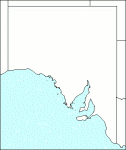Family: Asteraceae
Helichrysum bracteatum
Citation:
Andrews, Bot. Rep. 6:t. 428 (1805).
Synonymy: Xeranthemum bracteatum Vent., Jard. Malm. t. 2 (1804).
Common name: Golden everlasting, straw flower.
Description:
Very variable erect herb 20-80 cm tall, usually annual, sometimes perennial, with a stout tap root; stem and branches sparsely to densely scabrous-pubescent with septate non-glandular and minute glandular hairs; leaves sometimes slightly fleshy, narrowly to broadly oblanceolate or narrowly elliptic to lanceolate, with a rounded to acute, sometimes apiculate apex and cuneate to attenuate stem-clasping base, mostly 1.5-10 cm long, 5-20 mm wide scabrous-pubescent like the stem, especially on the margins.
Capitula terminating all lateral and terminal branchlets, forming irregular leafy sometimes panicle-like or corymb-like inflorescences, usually on peduncles up to 15 cm long, bearing distant reduced leaves, hemispherical to broadly so (the laminae of the involucral bracts initially oblique to patent, finally reflexed), 10-20 mm long, eventually 25-50 mm diam.; involucral bracts 8-12-seriate, the intermediate ones longest, all more or less rigidly scarious, opaque; outermost bracts stramineous, with short pale yellow laminae; intermediate bracts with obovate to ovate apiculate bright-yellow, rarely white laminae up to 18 mm long, exceeding the florets by c. 10 mm, the outer ones often with maroon or brown streaks, all with broadly oblong sparsely glandular-pubescent stramineous claws, subequal to the laminae and with finely serrate translucent margins; florets numerous, bisexual but for an outer row of female ones: style branches subterete, with finely papillose apices.
Achenes oblong-terete, obscurely 4-angled, dark-brown, glabrous, smooth; pappus bristles c. 25, slightly connate at the base and falling in groups, subplumose at the base, barbellate in the upper two-thirds, with a few longer barbs at the tips, bright-yellow.
Published illustration:
Cunningham et al. (1982) Plants of western New South Wales, p. 698.
|
|
Distribution:
|
Widespread in various situations, usually on sandy to sandy loam soils, in open woodland or forest.
All States.
|
Conservation status:
native
Flowering time: much of the year but mostly Aug. — Nov.
|

SA Distribution Map based
on current data relating to
specimens held in the
State Herbarium of South Australia
|
Biology:
A polymorphic species in need of detailed taxonomic study. Intensive plant breeding in Germany last century produced an outstanding array of colour forms ranging from white through yellow to deep-red and purple, popular in ornamental horticulture.
Author:
Not yet available
|

